Of the Antecedents of the Chinese Horse
Before attempting to describe the series of reliefs so widely known as the Horses of Tang T’ai-tsung, two of which are now in the University Museum, it will be desirable to say something about the prominent part which the horse has played since the earliest times in the life of the Chinese people, and also about the causes which brought about that remarkable efflorescence of all the arts of civilized life which took place in China in the first half of the seventh century of our era. For, without this background, an adequate conception of the outstanding importance of these sculptures and of the way in which they are linked up with the history, legend, and art of the entire East could not be had.
One of the salient features of the life of the ancient Chinese was their healthy devotion to all sorts of manly sports and pastimes. With a country sparsely settled, well wooded, swarming with dangerous wild animals, and surrounded by hostile non-Chinese tribes, and with a society organized upon a primitive feudal basis, the principal occupations of the ruling classes were necessarily war and the chase. In both these the horse played a conspicuous part.

Museum Object Number: C395
Image Number: 1259
When, or from what source, the horse first reached China is still undisclosed, although according to Chinese story the ancestor of the entire equine race dwells to this day in the skies, as the quadrille of stars known as Fang (Scorpio). When authentic history opens, about the twelfth century B.C., the horse had already long been in the possession of the Chinese; but he was not as yet used for riding, but was invariably driven, yoked to a chariot or car. This point is most important, for it serves as an additional piece of evidence connecting the beginnings of Chinese civilization with those of the settled and highly organized communities of western Asia and the Mediterranean world. Throughout antiquity, wherever the horse first makes his appearance, whether it be on the monuments of Egypt, of Assyria or of Asia Minor, in the ancient poems of the Aryan invaders of India, the epics of Homer, or the sacred books of the Hebrews, he always appears as a draught and not as a riding animal. That horses were occasionally used as mounts is true, as in the well known instance where Diomed and Odysseus, after their nocturnal raid on the Trojan camp, rode back on the horses of the Thracian Rhesus. But such an act was exceptional, and not the common practice, and fighting on horseback was entirely unknown. Exactly the same state of affairs prevailed in ancient China.
The Chinese chariots of those distant days seem to have been of a more archaic type, less differentiated from the ordinary primitive cart, than were those in use in the western world. Often they were very richly ornamented. Sometimes the wood work was of sandalwood, and the sides were paneled with varicolored bamboo splints woven in different chequered designs. To the hubs was applied a brilliant red lacquer, while the pole, rail, and other conspicuous parts were decorated with jade, ivory, bronze, gilding, and protective lashings of bright red leather. Tiger skin rugs added their orange and black to the scheme. Supported along the sides of the car were bow cases, javelins, and standards of feathers and oxtails and silken stuffs, the latter bearing various symbolic designs somewhat after the manner of our medieval European armorial bearings. For the Imperial car alone was reserved the great dragon banner, whose appearance in the field showed that the Son_ of Heaven himself was moving against his foes.
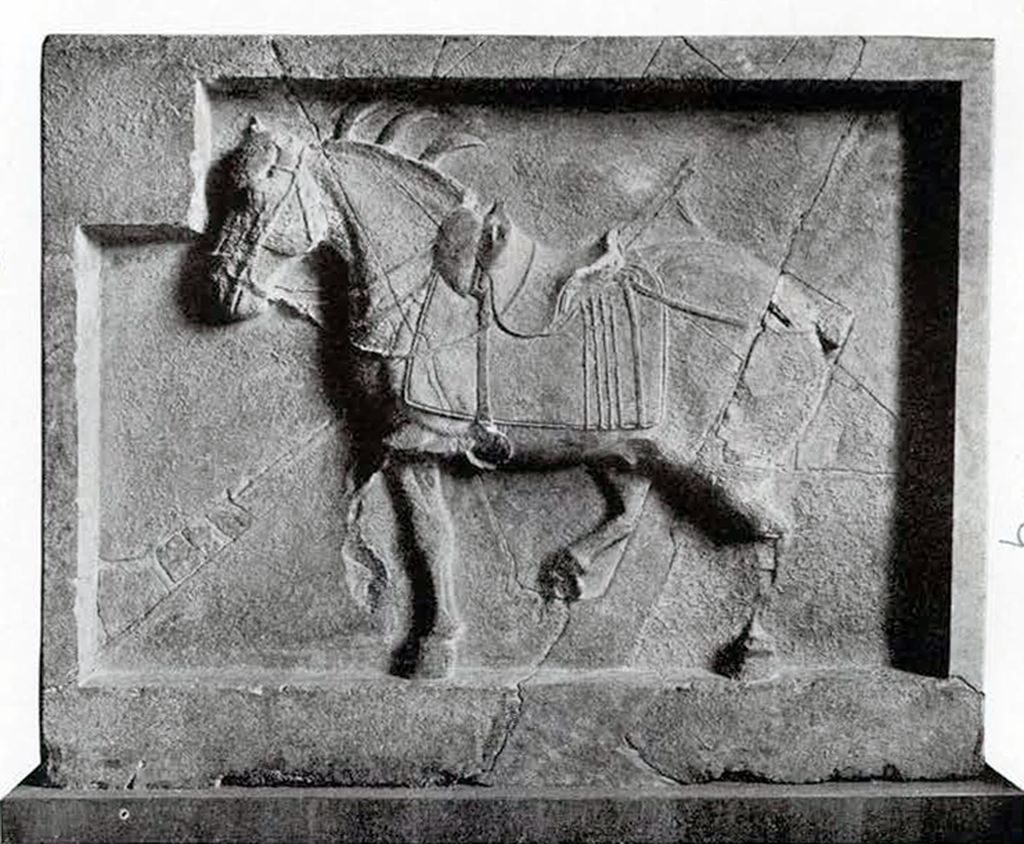
Museum Object Number: C396
There was little harness, properly speaking. Instead of using a collar or breastband and traces, the ancient Chinese attached their horses to their chariots by means of yokes, like the other chariot using peoples of antiquity. In the case of a quadriga, or four horse chariot, the two outside animals appear to have been attached to the body of the car, or perhaps to the axle, with traces; they were hitched not quite abreast of the two yoke fellows, but a trifle to the rear. To drive a team thus loosely harnessed, at headlong speed, over broken country, and often in the face of showers of hostile arrows, called for nerve and skill, yet many such instances are mentioned in the ancient Chinese records and poems.
The Shi-king, or “Book of Odes,” much of whose contents was composed not far from three thousand years ago, is full of glowing accounts of the splendid equipages with which the great men of that day were wont to go forth to war or the chase. The following lines describe the war chariot of a feudal lord absent upon an expedition against the non-Chinese tribes of the distant west:
And in five places shines, with leather bound;
The slip rings and the side straps; the masked place,
Where gilt rings to the front unite the trace;
The mat of tiger’s skin; the naves so long;
The steeds, with left legs white, and piebalds, strong.
Such my lord’s car! . . . . . . . . . . . . . . .
. . . . . . . . . . . . . . . . . . . . . . . . . . . . .
Shields, dragon figured, rise up side by side,
Shelter in front ‘gainst missiles to provide.
. . . . . . . . . . . . . . . . . . . . . . . . . . . . .
With measured steps move the mail covered team.
The trident spears, with gilded shaft ends gleam.
The feather figured shield, of beauty rare,
He holds before him, all his foes to dare.
The bow case, made of tiger’s skin, and bright
With metal plates, lies ready for the fight.
It holds two bows, which bamboo frames secure,
And keeps unhurt, to send the arrows sure.”
Legge’s translation.
The type of horses attached to these chariots seems to have been but little removed from those portrayed in the cave paintings of the Old Stone Age—small, with large head, coarse extremities, a ewe neck, and an inclination to paunchiness. The breed was at one time apparently very widespread in the Far East, and is still to be met with in out of the way places in China, Japan and Korea. If a tendency to variation in color is a sign of long domestication, as seems to be the case with some animals at least, then the Chinese horse must have been domesticated at an extremely early period; for the records mention black, white, yellow, piebald, bay, chestnut, dapple gray, and cream colored.
The Earliest Riders.
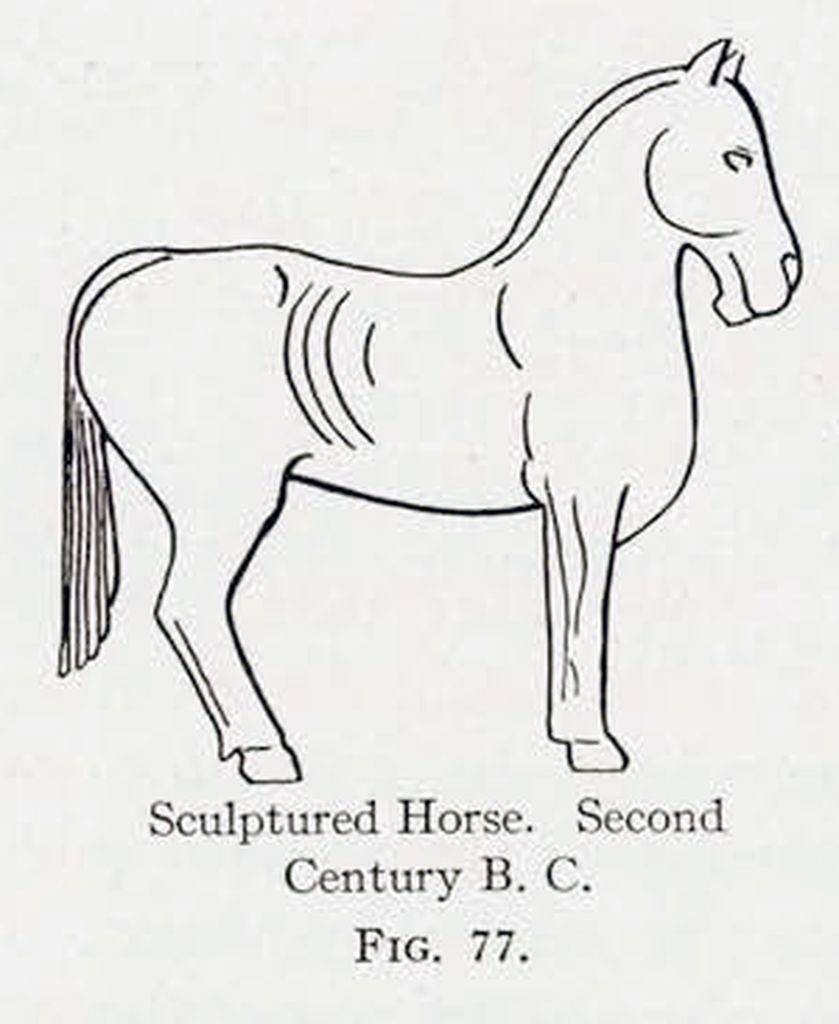
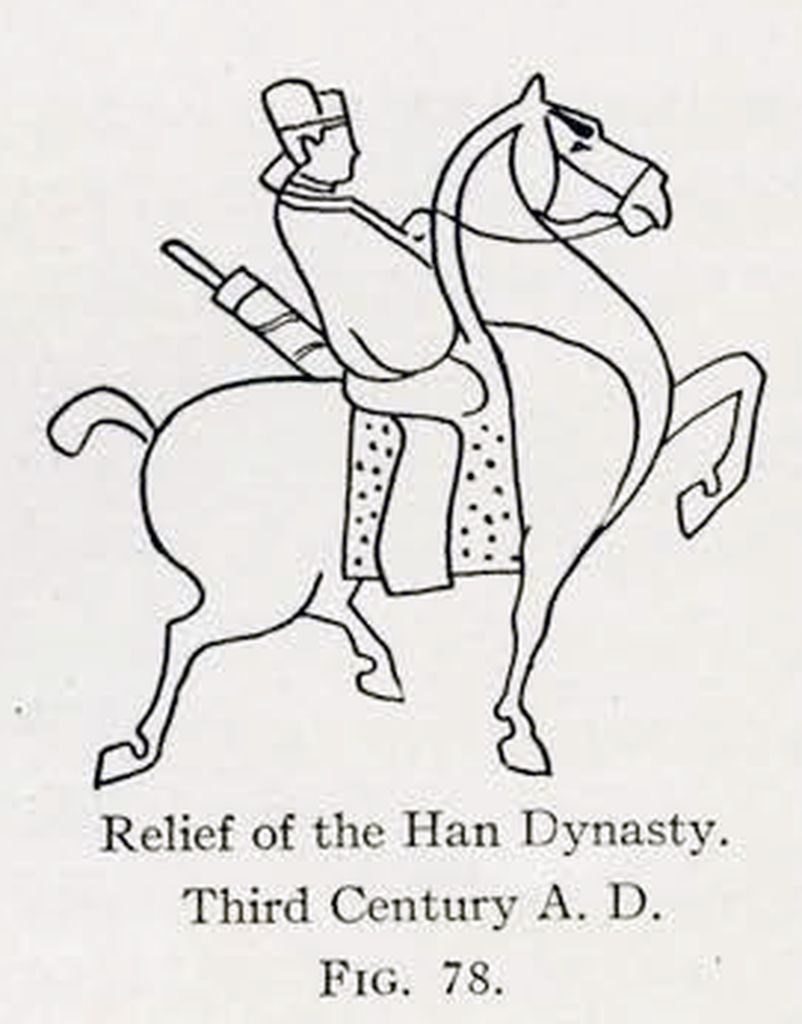
This archaic and very interesting use of the horse as a chariot animal originating far back in prehistoric ages, in that unknown center whence flowed the earliest civilizations both of East and of West, was destined in time to be brought to a somewhat violent end. Somewhere in the mysterious heart of Asia a people were evolving the art of fighting on horseback. Just when this evolution took place, or to whom it was due, we can not tell ; but we do know that once started, it spread throughout the Great Plains region of the ancient world, from the steppes of Mongolia to those of the Ukraine, exactly as it did among the western Indians of our own country after the introduction of the horse by the Spanish conquistadores.
The importance of this invention can not be exaggerated. An army of horse bowmen, led by a man of genius, as has so startlingly often been the case, was capable of doing about as it pleased with the lumbering masses of chariots and the levies of untrained and unwarlike peasantry that formed the armies of the civilized peoples of the earlier historical period. Even the legionaries of Rome, the finest infantry of their day, were helpless when they encountered the swarms of Parthian mounted archers on the fatal field of Carrhae. It was these nomadic tribes of Central Asia, with their hordes of irregular light horse, their genius for cataclysmic destruction, and their savage cruelty, that have constituted the real “Yellow Peril,” and civilized and agricultural China has suffered from this danger in precisely the same way as have the nations of the Near East and of Europe.
The new danger appears to have precipitated itself upon the nations both of the East and of the West at about the same period; that is to say, during the first half of the first millennium B.C. And wherever it appeared it was with the most appalling consequences. It was not for nothing that St. Louis of France gave to the Mongols, who, in the thirteenth century of our era, were threatening the total overthrow of civilization throughout the Eurasiatic continent, the nickname of “Tartars”—denizens of Tartarus itself ; for the conquests of these Central Asiatic marauders, whether Tartar or Hun or Bulgar or Mongol or Turk, have invariably been attended with the same bestial cruelty of which the latest examples have been exhibited in Armenia and Serbia during the past four years. These attacks, from which civilization has been suffering at intervals for almost three thousand years and which have seemed more than once to be on the verge of setting back the progress of the world indefinitely, have often been described; but nowhere, I think, with such terrible simplicity as in certain passages of the Old Testament. The Asiatic Scythians, it will be remembered, appeared in Assyria and Media in the seventh century before our era, one wing of the horde sweeping through the Holy Land and as far as the confines of Egypt. That this invasion of horse bowmen from Central Asia was something new to the people of Palestine, and that they were almost stunned by its overwhelmingly destructive character, is indicated in very many passages in the Old Testament such as the following.
Thus saith the Lord, Behold a people cometh from the north country, and a great nation shall be raised from the sides of the earth. They shall lay hold on bow and spear; they are cruel and have no mercy; their voice roareth like the sea; and they ride upon horses, set in array as men for war against thee, 0 daughter of Zion.
And again.
A fire devoureth before them; and behind them a flame burneth: the land is as the Garden of Eden before them, and behind them a desolate wilderness; yea, and nothing shall escape them.
This same scourge began to make itself felt about the same time at the other extremity of Asia. The Chou dynasty of China, with which the authentic history of that country really begins, arose, toward the close of the second millennium B.C., as a small “barbarous” feudal state in the extreme northwest of what is now China Proper. It was barbarous, however, only from the official Chinese point of view; for, seated athwart the eastern end of the main trade route between China and western Asia, this little state was in many ways in advance of the orthodox Chinese states themselves, particularly in matters of political and military organization. In the year 1122 B.C., according to the usual chronology, the head of this duchy, with the aid of certain other western tribes, overthrew the last ruler of the Shang dynasty and usurped his place at the head of the confederated Chinese states. For over three centuries, however, the rulers of the new line remained in their original capital, on the extreme border of China, undoubtedly for the purpose of keeping an eye on their northern and western neighbors. When these same neighbors had aided them in conquering China, toward the close of the twelfth century B.C., their forces had consisted of chariots and infantry, like those of the Chou duchy itself and of China Proper. During the next few centuries, however, things underwent a change in this respect, and presently we begin to find the Chinese troops having to do with nimble marauding bodies of horse bowmen, the precursors of the later Huns, Mongols and Turks. Early in the eighth century B.C. the pressure from these enemies became so strong that the Chou dynasty was forced out of its ancient capital and compelled to move far away to the east, behind the protecting barrier of the hill country of western Ho-nan. Thus we find both China and the extreme west of Asia, at about the same period, undergoing invasion from enemies of the same type, the pastoral, predatory light cavalry of the steppe regions of Central Asia.
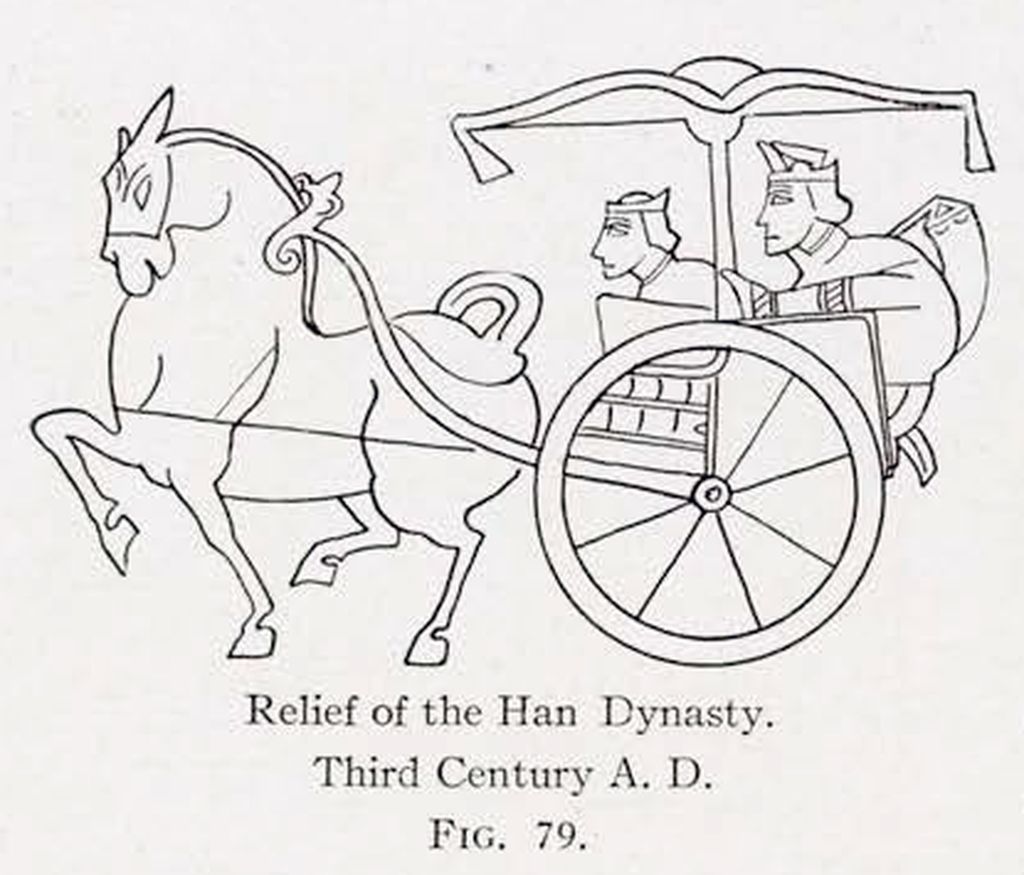
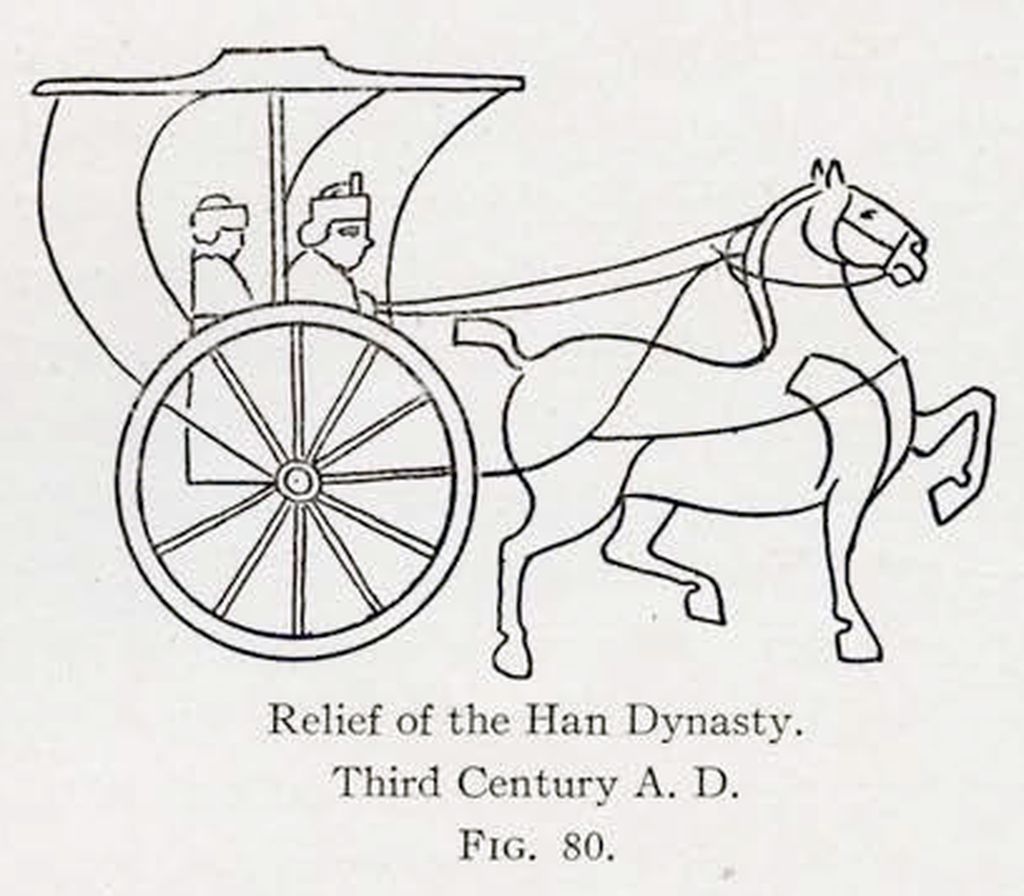
In time, of course, both in China and in the western world, civilization reasserted itself and the Central Asian peril was met. The device used both in Europe and in Asia was the same. Just as the Emperor Henry the Fowler, in the tenth century, through the creation of an adequate mounted force, was able to defeat the barbarous Hungarians who had been ravaging Europe at will, so did the Chinese rulers of the last centuries before our era begin to develop a national cavalry, with which, in time, they were able not merely to repel their secular foes but also to chase them back into their own limitless plains, to beat them, scatter them, drive them in part to the uttermost regions of the earth, and in part to conquer them, at least for a season. It was under the Former, orWestern, Han dynasty (206 B.C.-9 A.D.) that the Chinese people first came into direct and conscious contact with the great civilized nations of western Asia. One of the principal incentives which impelled the Chinese government to extend its influence in those regions was the desire to improve the quality of its cavalry remounts. There are a few slight indications in the “Classics” that from a very early time the regions to the northwest and west of the little Chinese confederacy of that day were regarded as possessing horses of better quality than were to be had in China Proper. For example, there is mention of an oracle to the effect that “the divine horse will come from the northwest.” Again, when the famous Wen Wang, Duke of Chou and Warden of the Northwestern Marches, was imprisoned by the last sovereign of the Shang dynasty under suspicion (probably entirely justified) of meditating treason, his fellow tribesmen got him out by paying a ransom which included some especially fine horses.
It was not, however, until the year 126 B.C., when the famous explorer Chang K’ien returned to China after twelve years of wanderings and adventures in distant western regions in search of a lost Tartar tribe with which the emperor wished to conclude an alliance against the Huns, that the Chinese learned anything definite regarding the great civilized nations occupying the other extremity of Asia. Among other things they then ascertained that in a kingdom far to the west, in the region which we now know as Ferghana, were wonderful horses, far superior to any then known in China. The interest of the emperor was at once aroused, and he sent an embassy to attempt to secure some of these “heavenly horses, ” as they were called, for the imperial stables. Their owners, secure in their enormous distance from the Chinese frontier, refused his advances with disdain. Thereupon the emperor sent a large army, probably the most gigantic horse stealing expedition on record, which, after some initial misfortunes, succeeded in its mission and returned in triumph to China, bringing with it a number of the coveted horses. This breed has been identified by some with the famous “blood sweating” Nisaean horses, mentioned by Greek writers as being bred in the upland pastures of Cappadocia for the use of the Great Kings of Persia. It is, however, a far cry from Asia Minor, at one end of the huge Persian Empire, to Ferghana, at the other, in what we now call Russian Turkestan. Further, the type of horse represented on the sculptured reliefs of the latter part of the Han dynasty, some three centuries after Chang K’ien’s time, does not answer at all to the description given of the Nisaean horses by the classical writers, who dwell particularly on their great height; whereas the animals shown en the Chinese reliefs are distinctly stocky, with well developed barrel, thick neck, short legs and well shaped head. This type occurs also, as might be expected, in ancient Bactria, lying, as it did, almost next door to Ferghana. It is shown to perfection, for example, on a gold medal struck by Eucratides, a Greco-Bactrian king of the second century B.C., and now preserved in the Bibliothèque nationale at Paris. The same type is also represented on the famous cliff carvings of the Sassanian period at Naksh-i-Rustam and Tak-i-Bostan, in Persia, dating from the third to the sixth centuries of our era. Apparently it is this same breed which the central Asian explorer, Vámbéry, found among certain tribes of Turkomans, and which he describes as being distinguished less for size and speed than for strength and endurance. Finally, it is the type represented, with such consummate artistic feeling, on the reliefs representing the famous chargers of T’ang T’ai-tsung.
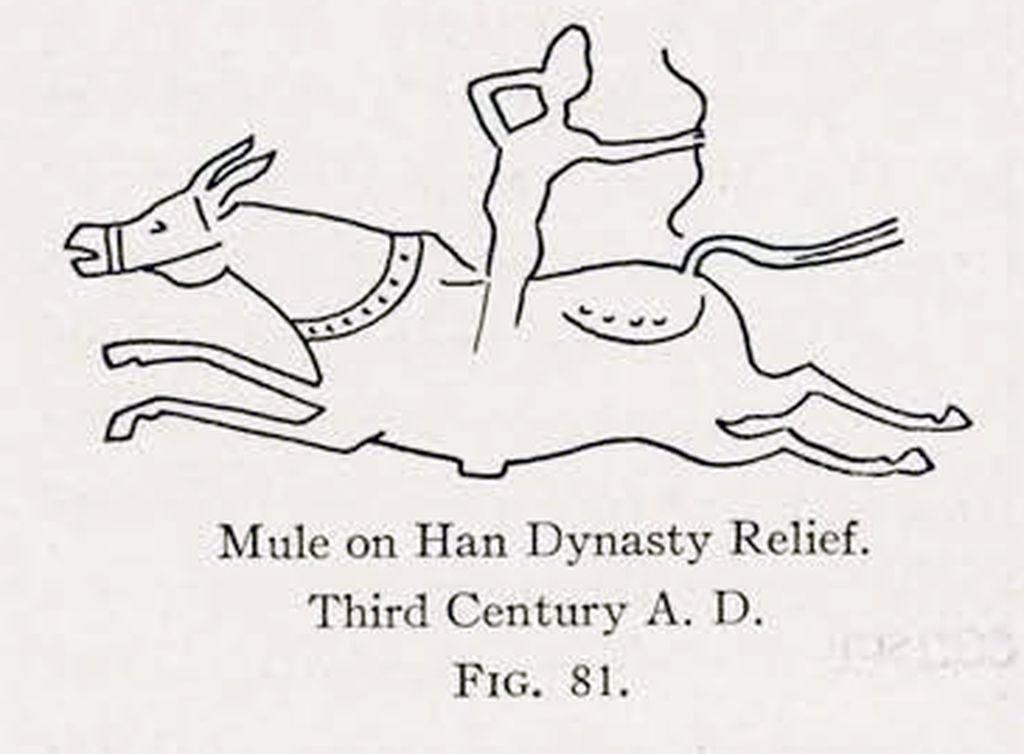
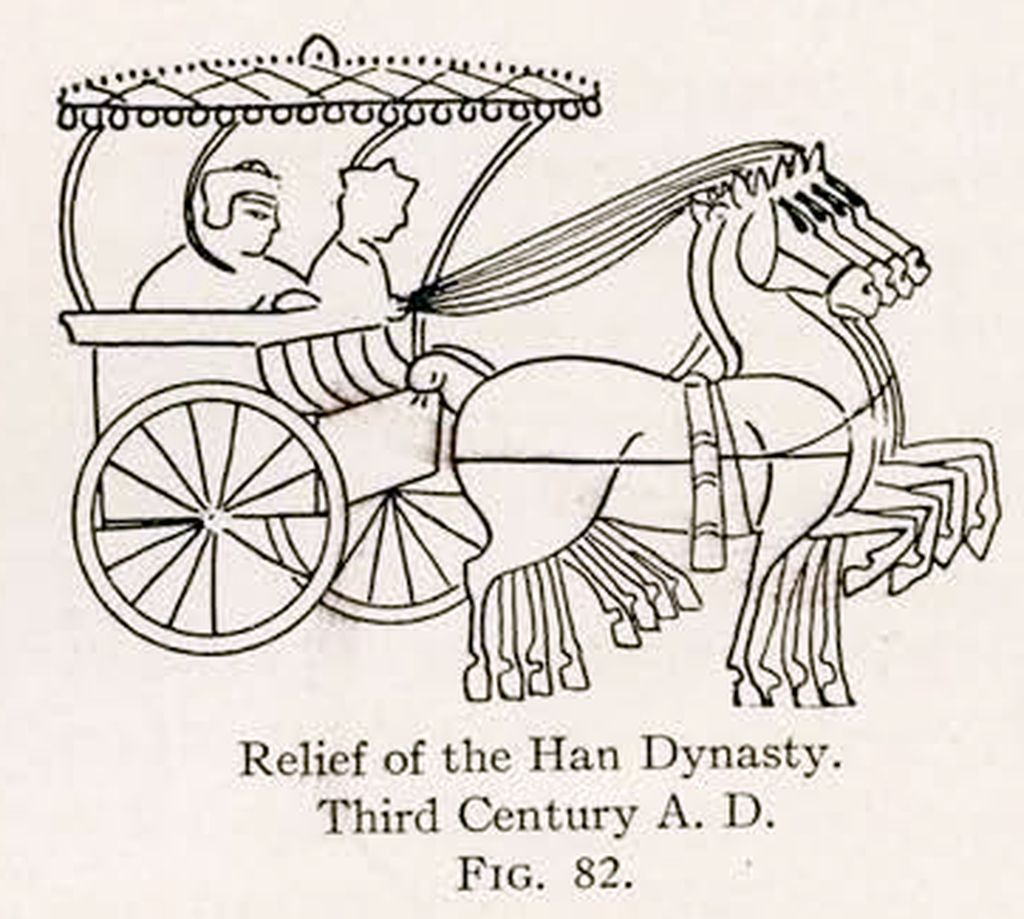
The mounted troops of the Chinese, formed as they were to cope with the Tartars on an equal basis, naturally at first took the form of horse archers. By the beginning of the Christian era, however, they had developed into an effective force of true cavalry, fighting not at a distance, with missile weapons, but through momentum, by charging home on the enemy at top speed and fighting hand to hand with lance and saber and battleaxe. In other words, the Chinese warrior, from being a charioteer or a mounted archer, had become a knight. The heavily armed and armored man at arms began to play the same preponderant part in warfare that he was destined to do in western Europe a thousand years later. The famous general Ma Yuan, who died in 49 A.D., used to say that “the horse is the foundation of all military operations.” No European knight, in the proudest days of chivalry, could have expressed himself more strongly on the importance of the mounted arm. This evolution of a heavy cavalry was accompanied by the development of a code of honor quite worthy of comparison with that by which European knights were supposed to govern their lives. No finer patterns of loyalty, patriotism, and self sacrifice are to be found anywhere than among the exemplars of this Chinese code, which, many centuries later, afforded the inspiration for the well known Japanese system of Bushido. The noted Ma Yuan, already quoted, whose memory is kept green to this day in the hearts of his countrymen, expressed himself to the effect that it was “better for a general to be brought back in a horse’s hide [i.e., as a corpse wrapped up in the rough cerements of the battlefield] than to die in his bed, surrounded by his children.” It is pleasant to know that the old warrior had his wish; for he died in harness, on a campaign against the wild aboriginal tribes of the south, when well on toward his seventieth year.
The collapse of the great Han dynasty, early in the third century of our era, after over four hundred years of rule, saw one of those partitions of China which have so often taken place in her long history. Three kingdoms sprang up, and this period, a brief one of only forty-five years (A.D. 220-265), is still regarded as the Golden Age of Chinese chivalry and heroism. Among other worthies, the God of War himself flourished and fought and died during these stirring times. In life he was a sort of Chinese Bayard, and like Bayard he died a heroic death at the hands of the foe. His tomb, which I visited in the spring of 1917, is shown near the ancient capital of Lo-yang, while temples dedicated to him are to be found all over China; on the walls are often frescoes showing him mounted on a fiery charger and performing deeds of daring outdoing those of the Paladins. It was believed that the great Japanese invasion of Korea near the close of the sixteenth century was brought to naught through his intervention, much as the Great Twin Brethren interfered on behalf of the Romans at the Battle of Lake Regillus, or as St. James of Compostela opportunely came to the aid of Cortez and his fainting men when they were on the point of being overwhelmed by the Aztecs at Otumba.
For three centuries longer Chinese history presents a woeful picture of continual strife, rebellion, invasion, turmoil; the setting up of ephemeral dynasties ruling over such portions of the dismembered empire as they were able to snatch from their rivals; and the overthrow of these dynasties by others as short lived. Northern China through much of this time was under the dominance of various Tartar powers, among which that called the Northern Wei is the best known. The period was thus one naturally favorable to the progress of the art of war, and particularly of cavalry fighting, which we find thoroughly well developed toward its close, late in the sixth century, when, under the brief dynasty known as the Sui (589-618), “the rent garment of China was again, with bloody fingers, stitched together.”

The second monarch of this line, sometimes called the Chinese Caligula, was a man of great ability, a magnificent patron of literature and art, but heartless, self willed, and a coward to boot. Instead of allowing the nation, almost ruined by four hundred years of desolating warfare, time to recover itself, he plunged into an ill advised and badly managed attempt to conquer the kingdom of Korea. This wholly unjustifiable war was forced by the emperor, in spite of the frightful suffering which it brought upon the people, until the whole empire was seething with discontent. Among the generals of that day was one, a certain Li Yuan, of whose popularity the emperor became jealous, although apparently without any real cause, for Li seems to have been rather a bluff, hearty, soldierly sort of person, a hard fighter rather than an intriguer or a potential traitor. He is said, among other feats, to have won his wife, the beautiful and noble spirited daughter of Tou I, by his skill at a shooting match. In order to put his follower out of the way the emperor concocted a scheme recalling that which David put into effect against Uriah the Hittite when he had him treacherously killed at the siege of Rabbah. Li Yuan was put in command of the post at T’ai-yüan, the capital of the present province of Shansi, with orders to hold it against the Tartars, then, as so often, threatening the northern frontier of the Celestial Empire. But, purposely, the emperor withheld sufficient troops from his officer, in order that he might be overcome and slain by the enemy, or else, being driven back by them, might be executed on a charge of letting the Tartars into the country.
The Founding of the Tang.
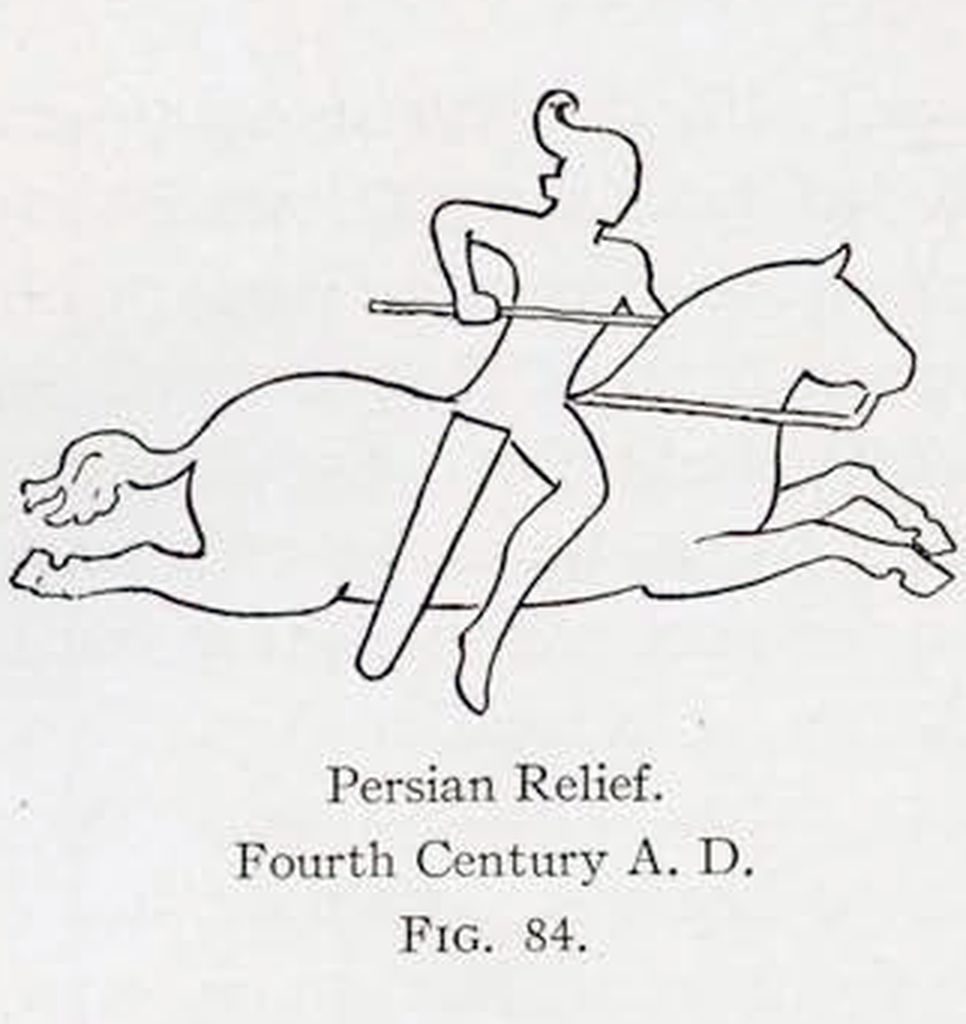
This plan would probably have succeeded, and the history of the Far East, and of the world for that matter, might have been changed, had it not been that General Li had a son, a youth at that time still in his ‘teens, named Li Shih-min (it will be remembered that in China the family name precedes the personal), who was destined to become one of the world’s very greatest men. He readily saw through the emperor’s treacherous scheme to eliminate his too popular officer. To counteract it, he advised his father to turn the tables on his imperial master by allying himself with the Tartars whom he was supposed to fight, and take advantage of the universal discontent aroused by the emperor’s Korean campaigns to make a bid for the throne himself. The old soldier, after passing a bad night in anxious thought, decided to take his son’s advice. In the fighting that followed, Li Shih-min seems beyond a doubt to have been the guiding spirit, and in the year 618, when he was only twenty-one, he had the satisfaction of seating his father on the Dragon Throne as first emperor of the line of T’ang. The eldest son of the new emperor—Li Shih-min being only the second born—became heir apparent.
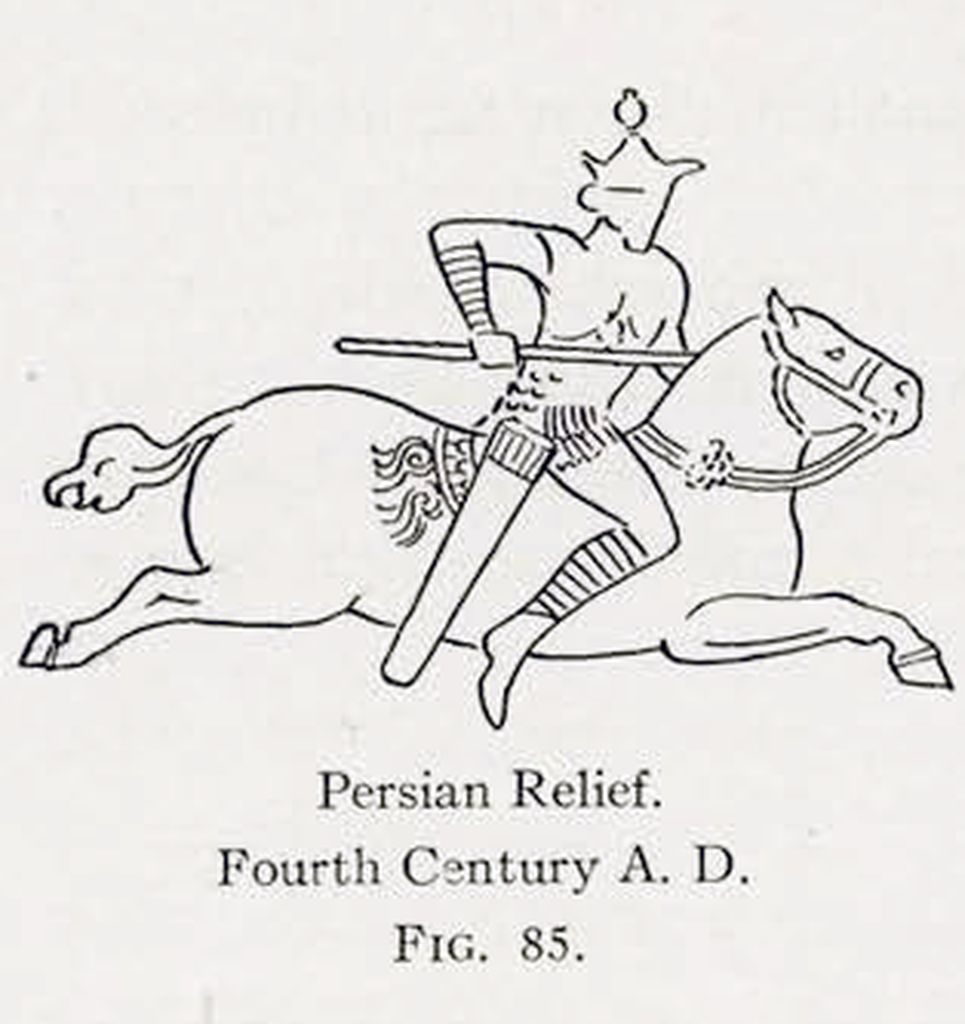
Li Shih-min spent the next eight years in the saddle, disposing one after another of the numerous competitors for the throne and beating back the Tartars, again become obstreperous, while his father, the emperor, attended to affairs of state, regulated taxation, reformed the currency, established a system of public schools, and made for himself a name as a capable and beneficent ruler. How far his policies were his own and how far they emanated from the master mind of his son, it is hard to say. We may be pretty sure that the father was a capable, hard headed old soldier who knew the right course when it was pointed out to him; but that he was an original thinker there is no proof. On the other hand, his son was a genius of the very first magnitude, not unworthy of comparison with any of the great men whom the world has produced, east or west. Hence, on the face of it, it appears likely that it was the son who was responsible not only for his own military successes in the field, but also for his father’s brilliant strokes of statecraft on the throne.
During these years of fighting, Shih-min, still a very young man, showed himself not merely a commander of the highest genius but also a fighter worthy of the best traditions of the craft anywhere. On many a bloody field, mounted on one or another of his famous six horses, he plunged into the thickest of the fight, daring arrow flights and spear thrusts and saber strokes with the boldest, and setting an example to his men that fully accounts for their loyalty and their uniform success under his command. In this, as in many other traits of character, Shih-min calls strongly to mind the equally youthful Alexander, who was also constantly running himself into danger, and even getting himself seriously wounded, at the head of his men.
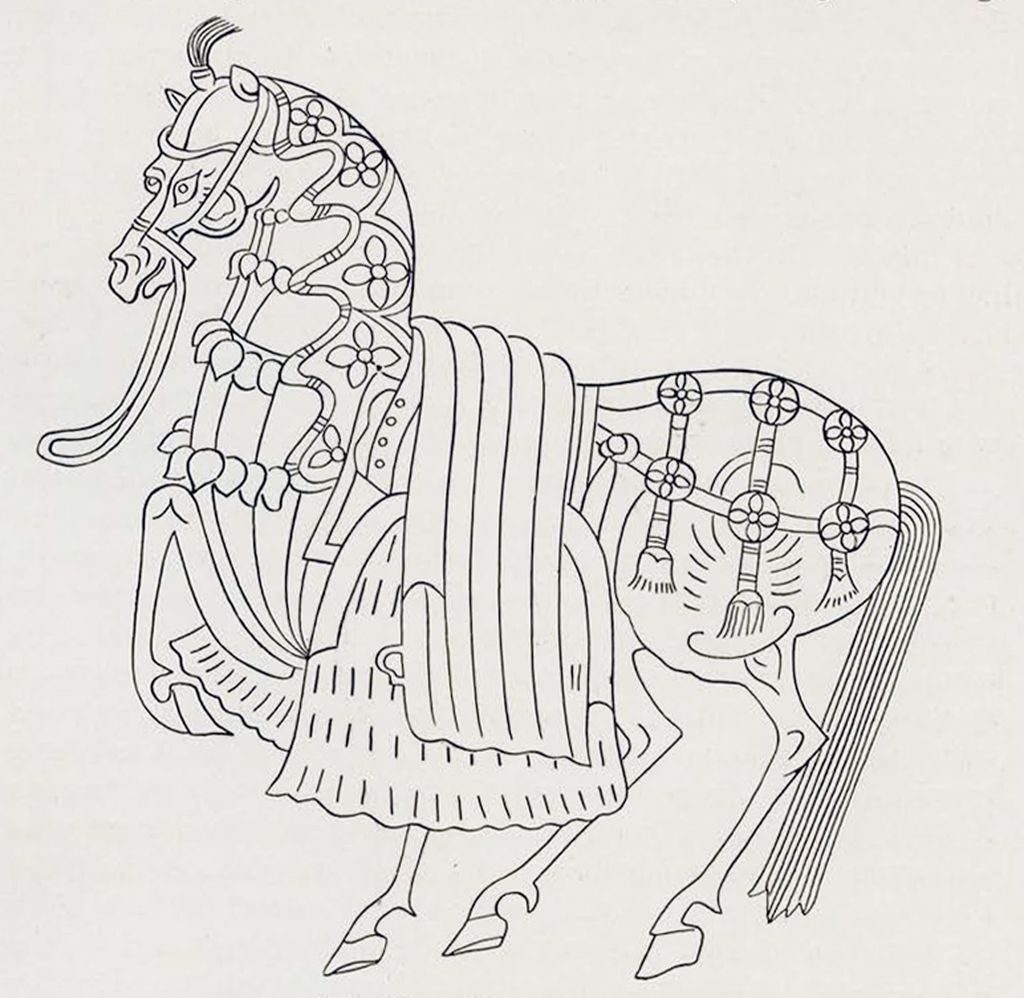
At length the time came when all enemies had disappeared, and Shih-min found himself at leisure to cultivate those arts of peace to which he was no less devoted than to those of war. His elder brother, the Prince Imperial, however, who owed his position as heir to the greatest throne in the world of that day solely to his brother’s genius, had become madly jealous of him, and began plotting to put him out of the way. One treacherous attempt at poisoning nearly succeeded, only Shih-min’s strong constitution pulling him through. Another attempt on his life, he learned, was to be made at a solemn state banquet. Thus forewarned, Shih-min laid an ambuscade for his elder brother, and with his own hand pierced him through with an arrow.
Shortly after this the emperor discovered that the cares of state were getting too much for him, and abdicated in favor of his great son, who thus mounted the throne, at the age of twenty-nine, and is known to later generations under his regnal name, T’ang T’ai-tsung.
There ensued one of the greatest and most brilliant reigns in the long history of the Chinese empire. A recent historian has said, “At this time China undoubtedly stood in the very forefront of civilization. She was then the most powerful, the most enlightened, the most progressive, and the best governed empire, not only in Asia, but on the face of the globe.” And when one considers what was going on in the rest of the civilized world during the first half of the seventh century, it becomes apparent that this praise is none too high. In China alone upon the globe, was to be found a single vast empire, flourishing, populous, civilized in the highest sense of the word; organized both for peace and for war, encouraging commerce and agriculture by sane laws, welcoming and protecting the devotees of every faith, and developing her art and literature and science to a point such as they had never yet attained at any time in her history. The age was one of those which, like the Periclean at Athens, the Augustan at Rome, or the Elizabethan in England, appear at long intervals in the history of our race, and which leave to those who come after a heritage imperishable for all time.
Progress Under the Tang Emperors.
Little of the progress in civilization that was made during this wonderful epoch has, it is safe to say, been lost; but its influence fails to be appreciated because of its very commonplaceness, just as one is not ordinarily conscious of the air which he breathes. The civilizing influences set in motion in China during the seventh and eighth and ninth centuries of our era have become an integral part of the world civilization of the present, and only expert and painstaking analysis could disclose, even in small part, which elements in particular we owe to the enlightened policies of the government set up by T’ang T’ai-tsung. As a single example, however, may be cited the case of the mariner’s compass. The liberal commercial laws of this period attracted to the Chinese seaports many Arab traders—men filled with the same spirit of enterprise and adventure as that which animated the soul of Sindbad the Sailor. From the Chinese these ready witted men learned the use of the compass, and carried it, eventually, to the Mediterranean. There it was taken up, at first with superstitious fear and trembling, by European navigators, in whose hands, in the fulness of time, it rendered possible the extension of civilization over the face of the globe.
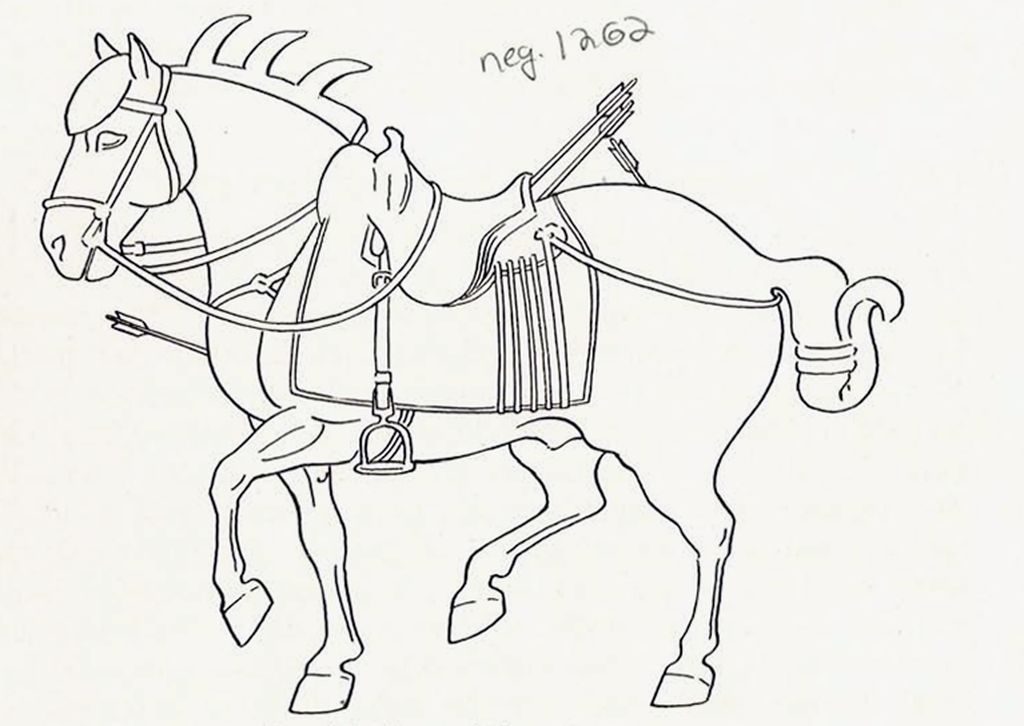
Image Number: 1262
Great as was the reign of T’ang T’ai-tsung in every field of human endeavor, nowhere was it greater than in its art. Unlike that of some of the later dynasties, this art was in no sense a conscious attempt to imitate and revive the canons and ideals of a past age. It was a wholly spontaneous development, a natural outgrowth of the spirit of the time. For many of its features, as we now know, it was indebted to influences originating in the West, and particularly in Persia. That this should be so was inevitable. The Mohammedan era began just four years after the establishment of the T’ang dynasty, and by the victories of Kadisiya, in 637, and of Nehavend, about 641, the Arabs utterly crushed the Sassanian monarchy, then ruling over Persia, and dispersed its adherents far and wide. It was natural that a country such as China then was, hospitable, tolerant, and powerful, should be the refuge of large numbers of the best elements of the population of highly civilized Persia who were unwilling to accept either the domination or the faith of the newly risen and still barbarous Moslems. The effect was almost precisely like that produced in Europe eight hundred years later, when Constantinople fell before the Turks, and Greek artists and scientists and men of letters were driven to take refuge in the still Christian countries to the west, and particularly in Italy. In the one case, as in the other, a Renaissance ensued.
Another foreign influence in the art of the T’ang period was that exerted by Buddhism. The Buddhist art of this period was a development of that of the preceding century, usually spoken of as the Northern Wei school, and this in turn was inspired by that of Khotan, in Central Asia, whither it had been brought by missionaries from northwestern India, with its Greco-Bactrian traditions.
Aside from all this, however, there was in the art of this period a certain element which gave it its distinctively Chinese character and individuality, and which in many of its manifestations may be traced back to the times of the scarcely less illustrious but far more archaic and less cosmopolitan Han dynasty, comprising the period immediately preceding and following the beginning of our era.
The Earliest Representations of the Horse.
Foreign visitors to Peking usually go out to see the famous tombs of the Ming emperors in their romantic valley in the hills to the north of the great city, and all who do so are impressed with the long series of figures, human and animal and mythical, which line the avenue of approach. The custom of installing these figures before a great man’s tomb did not, however, originate with the Ming dynasty (1368-1644). It occurs, on a less grandiose scale it is true, with tombs of emperors and great subjects of previous periods, and its earliest surviving example, so far as we yet know, dates back to the times of the Former or Western Han dynasty, being found in connection with a tomb of the year 117 B. C.
This tomb is that of the young general Ho Ch’u-ping, who died at the age of twenty-four, after having made for himself an enviable reputation as a brilliant cavalry leader and a horseman as bold and accomplished as any among the thousands whom he so ably led against the marauding Huns. Beginning military service as a petty official at the age of eighteen, before his death six years later he had risen to the office of president of the Board of War, and so great were the services which he crowded into his brief career that the emperor himself undertook the ceremonies attendant upon his sepulture.
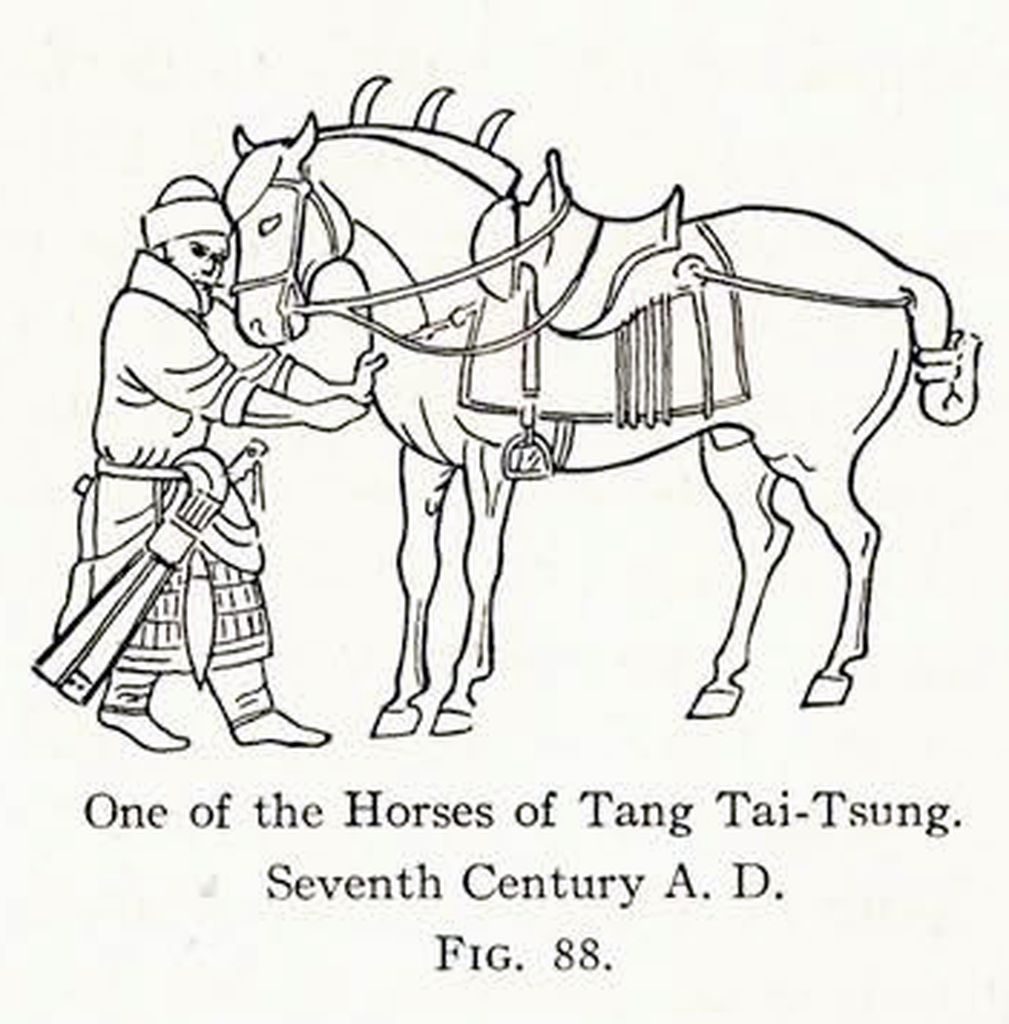
The tumulus erected over the dead warrior is still to be seen in the province of Shen-si, near the Wei, that famous river, whose valley has sometimes been called the cradle of Chinese civilization, and upon whose banks has stood China’s capital during nearly all the great epochs of her history. How many sculptured figures were erected before this tomb, what they represented, and how they were arranged, we do not know. Only one survives—the figure of a horse shown trampling into the ground one of those Huns so often trodden under foot by the brilliant young commander whose ashes rest under the neighboring mound. Doubtless another similar statue confronted the one which still survives, and there may have been still other pairs; but if so, they have either been carried away or have been covered up and hidden under the detritus washed down by the rains of over two thousand years.
The style of this figure is archaic, but it is in no sense primitive. The horse, without saddle or bridle, with long body and short thick legs and large head with pendulous lower lip, appears to be intended for one of the old breed, unimproved as yet by the infusion of finer blood from the “heavenly horses” of Ferghana. Nevertheless from the first the impression which one receives is one of strength exerted with dignity. The attitude is one of power held in reserve. There is no indication of great effort put forth. The horse is merely advancing with stately stride, and yet he is overwhelming and crushing the Hun who, with heavy beard and ferocious expression, his bow and spear in his hands, is vainly struggling beneath him.
Although this statue is the earliest example of Chinese sculpture now known to exist, it was certainly not one of the earliest executed. Everything about it points to a long previous development of the art somewhere, whether on Chinese soil or elsewhere. In 117 B. C. enough time can scarcely have elapsed since the return of the explorer Chang K’ien, with his news of the culture regions to the west, for an imported art to modify so conservative a feature of the national life as its funeral customs. Some trade there was then, and doubtless long had been, with civilized regions in India; but it was of a tribe to tribe sort, passing through the wilds of western China and Farther India, lands occupied then as now by savage races, and was in no sense a direct cultural contact between the two great peoples. Hence it would seem that there must have occurred on Chinese soil itself a previous development of the art of statuary, whether in stone or in bronze or in wood; and this view is confirmed by the occasional references to statues of various materials in the Chinese records prior to the time of the Han dynasty.
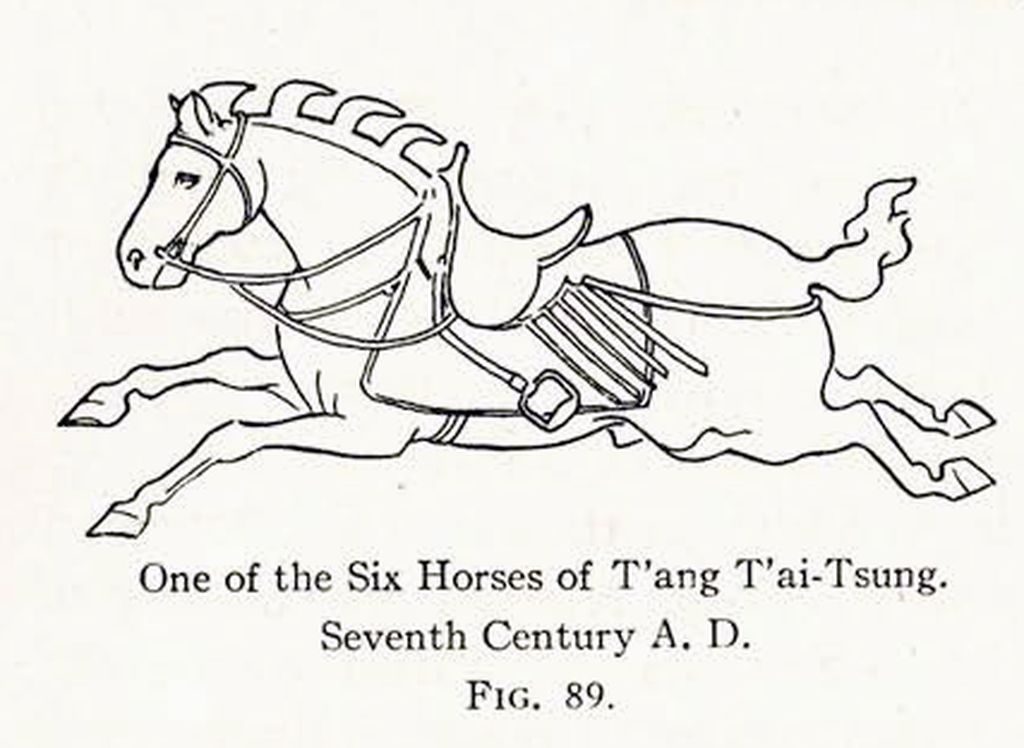
The next surviving representation of the horse in Chinese sculpture that has come to my knowledge is that to be found in a series of most interesting reliefs from certain tombs in the province of Shan-tung, in northeastern China. These date from a time toward the close of the Han dynasty, or not far from three hundred years after the example just described. These reliefs, which have attracted world wide attention of recent years, tell us much that we should not otherwise know regarding the life of that distant time. In many cases they represent well known incidents of peace and war which we are able to identify from literary sources. It was the custom at that period to decorate the walls of palaces and temples, and doubtless, too, the mansions of the well to do, with paintings of various subjects, and it is most probable that the intention in executing these reliefs was to make the mortuary chamber look as homelike as possible to the spirit of the departed.
It is noticeable that the horse plays a conspicuous part in these reliefs both as a draught and as a riding animal. There are gay processions of chariots, each usually shaded by a large umbrella and containing dignitaries in their long robes. There are battle scenes, where groups of mounted men contend with bow and lance. There are scenes, too, where armed men attack processions of chariots. Nowhere, however, is there any hint that the chariot was then used as a regular engine of war. Its day had passed. In its place is shown the mounted warrior, careering at full gallop over the stricken field and battling in just the way that we should expect from a perusal of the written records of the time.
Not the least striking thing about these reliefs is the success with which the action of the horses is represented. Whether the pace be a walk, or a trot, or a headlong gallop, the artist has been most successful in producing the impression which he wished to give. Here, again, there is nothing primitive or experimental about the work. It indicates clearly a long previous apprenticeship which had developed into a full mastery of style.
The Flying Gallop.
In connection with the manner of representing the horses in these reliefs a most interesting suggestion has been made regarding the source of part, at least, of the inspiration which had affected the development of Chinese art. The point, which was raised by an eminent French archeologist a number of years ago, has to do with the manner of representation of the gallop.
We are familiar, through the English sporting prints which began to come into vogue a little over a century ago, with the manner of indicating the gallop by showing the horse, with legs extended to the utmost, before and behind, “ventre à terre,” as the French picturesquely put it, apparently skimming through the air as if shot from a bow. That this attitude is only an artistic convention need, in these days of instantaneous photography, scarcely be said. The sole circumstance under which a horse thus extends himself, even for the fraction of a second, is when in the act of clearing an obstacle. Moreover, the origin of this convention is not in any sense due to the impression left upon the retina of the observer, else a galloping horse would always and everywhere have been represented thus, which is far from being the case. With only trifling exceptions, susceptible of another explanation, no galloping horse is thus represented on the monuments of Assyria or of Egypt or of classic Greece. In these lands the accepted conventional way of indicating the gallop was to represent the horse with his hind feet on the ground—sometimes, it is true, with barely the points of the hoofs touching—and with the forelegs raised and extended, an attitude which will at once recall itself to all who have seen examples of the art of those countries.
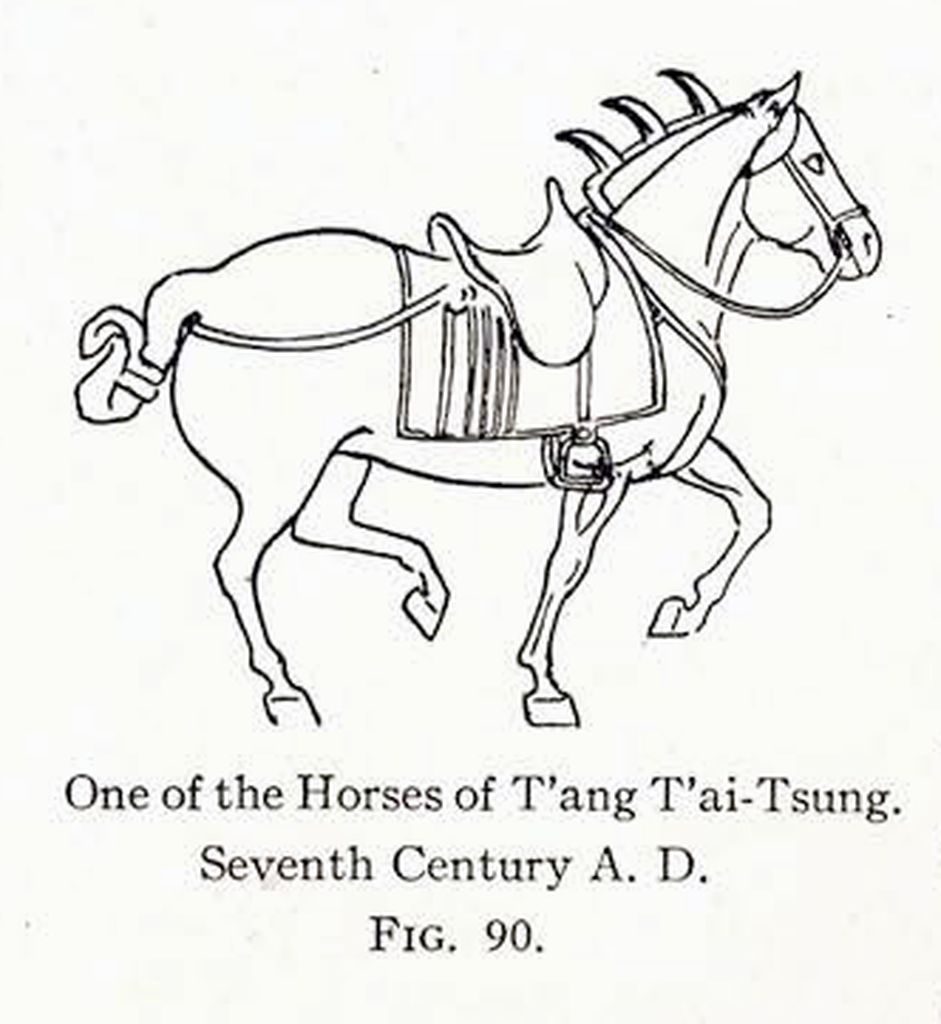
There was, however, in the ancient world one culture area in which the representations of both animals and men in motion were executed with a vigor and a force unknown elsewhere. This was in the art which we used to call Mycenean, but which now, since the great discoveries in Crete of the past two decades, is more generally known as the Minoan or Aegean. Here animals in rapid motion are regularly portrayed in the attitude of the “flying gallop,” with both pairs of legs extended and clear of the ground, in precisely the same way as that shown on the Han mortuary reliefs more than fifteen hundred years later.
All study points to the extreme unlikelihood of an independent invention of this same artistic convention in the two countries. The problem is, then, to derive the one from the other.
Naturally, one thinks of Persia, with her splendid civilization and her far reaching influence in the great days of her empire, as the channel of communication. Now, on the Sassanian carvings of Naksh-i-Rustam and Tak-i-Bostan in Persia, already mentioned, the artist has shown the galloping horse in precisely this way. Nothing of the sort, however, occurs in the previous art of that region, whether Parthian or Persian or Babylonian. The convention seems to have come in as an entirely new thing with the establishment of the Sassanian monarchy, or, in other words, about the middle of the third century of our era. This of course is almost a century later than the representation of the flying gallop on the Chinese reliefs, which effectually disposes of any theory of its derivation from Persia.
What seems actually to have occurred is this. The representation of a galloping animal with all four legs extended and clear of the ground, as if the animal were merely skimming the ground like a swallow, appears to have been developed first of all in the very spirited and energetic art of ancient Crete. Thence it spread, in preclassical times, to the regions north of the Black Sea (where, later, so many Greek colonies were founded), and eventually was carried, by independent routes, both to Sassanian Persia and to ancient China, apparently through the medium of the so-called Scythian culture which overspread so much of eastern Europe and central Asia in early days and which in many ways acted as a sort of connecting link between east and west.
The four hundred years of disunion and bloodshed and general misery which China had to undergo after the fall of the Han dynasty were little conducive either to the production or to the preservation of objects of art, and those which remain to us from this period are almost wholly of Buddhistic origin and exotic in inspiration. However, the native tradition as developed under the Han undoubtedly survived, and when the country was once more restored to unity and strength by the mighty founder of the T’ang dynasty, one of the earliest manifestations of this new period of greatness took the form of sculpture. How T’ai-tsung won his throne has already been explained; how he immortalized his six horses remains to be described.
Two Famous Horses in the Museum.
T’ang sculpture has been known heretofore almost entirely through its Buddhistic phases. These, as has already been pointed out, owe their ultimate inspiration to India, and hence have left us almost wholly in the dark regarding the development which was taking place in China along native lines. Recently, however, there have come to the University Museum two reliefs representing chargers of the famous founder of the T’ang dynasty, which not only possess the very highest intrinsic excellence both in spirit and in execution, but are of an importance which can not be exaggerated for the revelation which they impart regarding the high state of development of non-Buddhistic sculpture during that wonderful epoch.
The custom of erecting great mounds of earth over the graves of the illustrious dead is part of that common heritage, dating back at least as far as the latter part of the Stone Age, which the ancient Chinese shared with so many other races, in Europe as well as in Asia. Through dynasty after dynasty, from ages long antecedent to the dawn of history, the Chinese rulers were buried under great tumuli, which, with the persistence of earthworks everywhere, still rear themselves above the soil in vast numbers, particularly in regions like those of the river Wei in Shensi, or the Lo, in Ho-nan, where the power and culture and wealth of the Chinese people have been so often focused since prehistoric times. And when the mighty emperor T’ai-tsung, after one of the greatest reigns in history, passed away in the year 649, at the comparatively early age of fifty-two, he, too, was buried beneath a huge tumulus which still stands, not far from Li-ts’üan Hsien, to the northwest of the provincial capital, Si-an Fu.
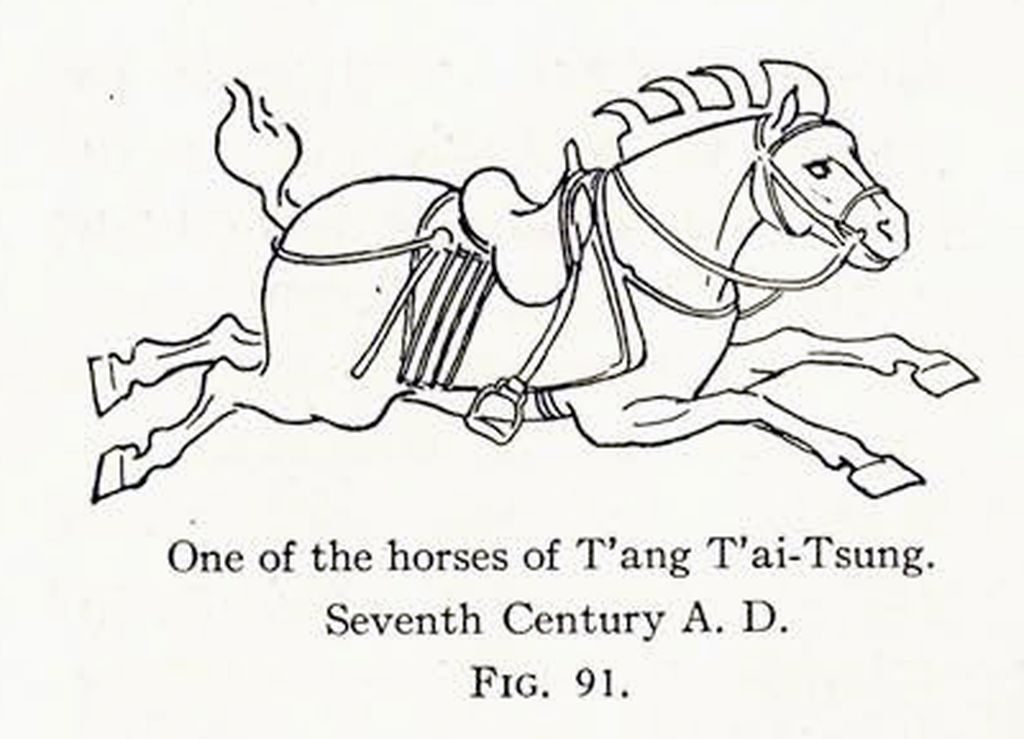
We are told that Cato, after the termination of his campaigns in Spain, remorselessly sold off his faithful old warhorse to the knackers, in order to set an example of sturdy Roman thrift and economy. Not so, however, with the horses that carried T’ang T’ai-tsung through his numerous battles. In life they were cherished and caressed and carefully tended, and in death their portraits adorned their master’s tomb. Two of these sculptured portraits, now in the University Museum, have caused me to gather and write down the historical matter contained in this paper.
Perhaps no horses ever existed which have become so famous. Few there are among the hundreds of millions of people inhabiting the regions of eastern Asia who have not heard of their marvelous swiftness and endurance and courage and of the very real part which they played in the making of the history of their time. In the course of ages there has clustered around them a great body of legend and story and song, and they have afforded the theme for many a great sculptor and painter whose works have been the delight and inspiration of not less than a full fourth part of the entire human race.
Like many another monarch, T’ang T’ai-tsung believed that the best way of assuring himself an adequate sepulchre, constructed and decorated in accordance with his own wishes and ideas, was to have the work carried out in his own lifetime. The task was completed in the year 644, just five years before his death, and it was only natural that the decorations on the walls of the mortuary chamber in front of the great mound should be commemorative of the victorious campaigns which he had fought, and of the territories which he had added to his empire. Among these decorations were statues of the various kings and Tartar khans and other chieftains whose lands he had annexed. In addition there were the reliefs of the famous six horses.
Of the artist who wrought these masterpieces, we know practically nothing beyond his name, Yu King-shu. That he was one of the greatest artists of his time, we might safely assume through the fact of his having been chosen to execute the carvings destined to grace the tomb of the emperor. The sculptures themselves proclaim him one of the greatest artists of any age or nation.
Each of the horses is represented upon a separate slab measuring approximately six feet in height by seven in breadth, and over a foot in thickness. As they were originally set up, around the interior walls of the mortuary chamber, each stood upon a pedestal bearing an appropriate inscription composed by the emperor himself and written by a famous calligrapher. These pedestals are said to have been lost, but it is well within the bounds of possibility that they may yet be found when proper excavations are undertaken. The wonder is, rather, that the horses themselves, exposed as they have been for nearly thirteen hundred years to the action of severe winter frosts, the iconoclasm of Mohammedan rebels, and the destructive caprices of an ignorant and superstitious peasantry, should have survived at all. And as it is, their battered condition speaks eloquently of the vicissitudes which they have undergone.
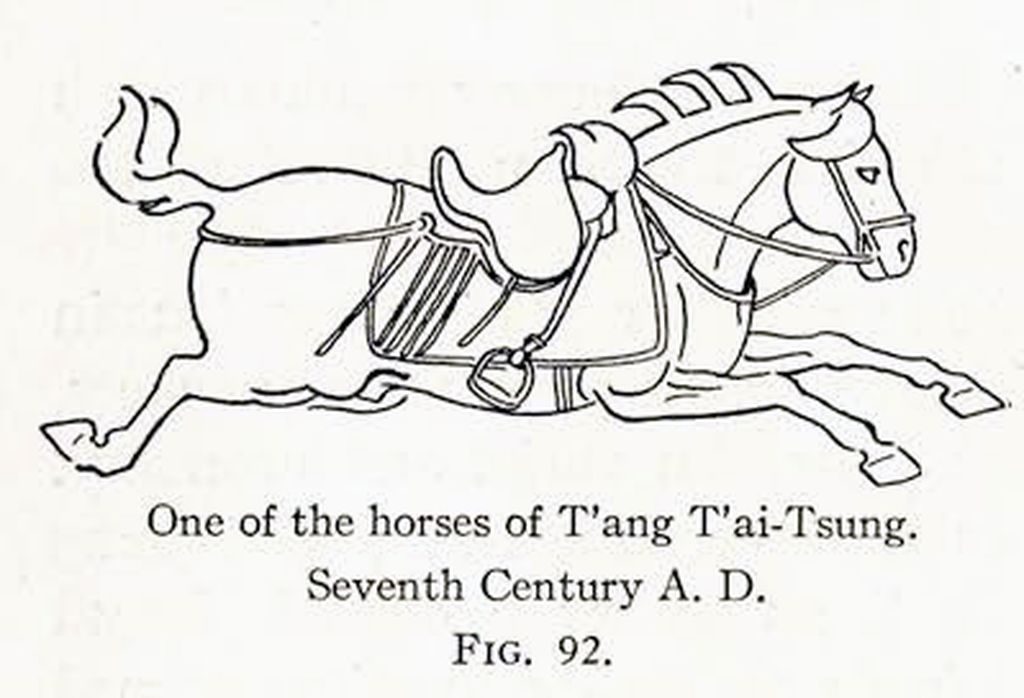
Image Number: 1262
When the great French scholar, Chavannes, whose recent death was such a loss to the progress of Chinese studies, visited and photographed these reliefs a few years ago, they were still to be found near the tomb of T’ang T’ai-tsung, and they had already sustained the injuries which they now display. Fortunately for the world, however, proper care and attention were soon to be bestowed upon them. When I visited the city of Si-an Fu on behalf of the University Museum, in the autumn of 1917, I was told that some years before, one of the military governors of the province, realizing the importance of these works, carried away the two best with him to Peking at the expiration of his term of office. It is these which, as already stated, made their way eventually to this country and which may now be seen in the Oriental Section of the University Museum. Awakened at last to a somewhat belated sense of the merits of these relics of a wonderful past, the authorities had the remaining four brought to Si-an Fu and set up in the newly established provincial museum, where, on the occasion of my visit, the curator, a fine type of the Chinese scholar and gentleman, gave me every facility for making studies and photographs of them.
It was the great emperor’s design, when he had these masterpieces executed, not merely to preserve to posterity the likenesses of his beloved chargers, but also to commemorate their names, their color, the battles in which they carried him, and the wounds which they incurred in his service. Not only was this information recorded, along with laudatory verses, in the inscriptions which graced the original pedestals, but each of the horses is shown pierced with arrows, according with the number and location of the wounds which it received in the different battles in which it participated. Some of the horses are shown in the attitude called the “flying gallop,” already discussed, and which is undoubtedly a direct inheritance from the art of the Han dynasty, with its apparently Scythian connections; others are walking, or standing; in one case alone is shown a groom, clad in Tartar costume, and engaged in extracting an arrow from the breast of his charge. This, which on the whole is probably the finest of the series, is one of those now to be seen at the University Museum.
The huge slab on which the scene is portrayed has its edges beveled all around, both back and front, and was ornamented around its borders with a tasteful arabesque and floral design, remains of which are still to be seen well down in the lower left hand portion. In the upper left hand corner is a rectangular smooth surface which also occurs in the others of the series, and which apparently was intended to bear an inscription; but this seems never to have been chiseled upon it, for no trace of it discloses itself, either in the two now in the University Museum or in those still remaining in China.
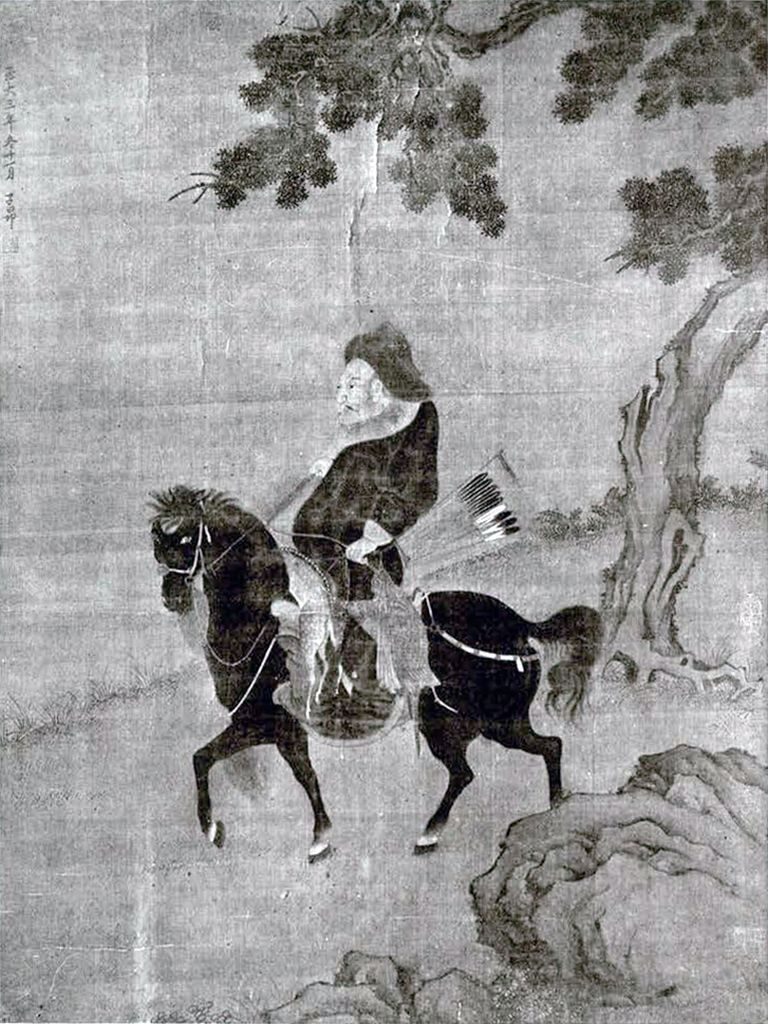
Museum Object Number: C448
The carving itself is executed in very high relief, against a deeply recessed and perfectly plain background surrounded by a raised border. Like the Greeks at their best, the great Chinese artists, whatever their medium of expression, have perfectly understood the effectiveness of plain surfaces as means of emphasis and contrast. There is nothing here to distract the attention of the observer from the central scene itself—the noble steed and the no less lifelike and splendidly executed figure of his groom. The very attitude of the horse implies courage and spirit; he seems almost in the very act of walking calmly up to have plucked out the arrow which has pierced him. We know that the scene is no fancy of the artist, but that it commemorates a historical incident, and it is this which so greatly enhances the interest with which we look upon it. The Greek sculptors idealized their horses, as they did their men and women; but here we have what seems a genuine portrait of a very real horse one of the noblest of his kind, it is true, but still one of earthly breed, even though no doubt bearing in his veins the blood of the famous “heavenly” steeds brought so long before from distant Ferghana. The fine head, the strong neck, the flowing lines of the muscles, like springs of steel under velvet, the shapely legs and delicate hoofs and the sturdy, well rounded barrel are those of an animal such as we should expect a daring soldier and keen horseman like T’ang T’ai-tsung to choose for his own.
The housings are indicated with rare skill, and in addition to their artistic interest are of value for the light which they throw upon the way in which the chargers of that day were saddled and bridled. In many ways the style has altered surprisingly little in the thirteen hundred years that have gone by since these famous steeds were coursing the battlefield. The mane is hogged and knotted and the tail carefully tied up in precisely the fashion which Chinese grooms follow to this day. The headstall and short high saddle and saddle cloth might be seen anywhere on the horses of the well to do in the northern China of the present. This style of saddle, with its extremely short stirrups, the Chinese apparently borrowed from the Tartars in very early times, and it is still characteristic. It was once my fortune to perform a journey of some length in western China upon such a saddle, and my respect for the horsemanship of the Chinese warriors and their Hunnish foes was vastly enhanced thereby. It must surely have been only the most consummate skill that enabled them, thus precariously seated, to gallop and charge and wheel and perform the various evolutions characteristic of the desperate cavalry fights which we know went on for so many centuries. It has been only by rare exception that any of the peoples of eastern Asia have ridden with long stirrups, so much so, in fact, that Marco Polo mentions as one of the most noticeable traits of a certain people that “they ride long, as the Franks [i.e., Europeans] do.”
The figure of the groom, who stands confronting the horse, in the act of drawing out an arrow from its breast, is no less ably drawn. The pose, with the left hand firmly pressed against the horse’s body and the left foot advanced, to provide a fulcrum while he tugs at the arrow, is very effective. By his costume he appears to be a Tartar—perhaps, as often happened, a Tartar captive who had assumed charge of his imperial master’s steeds. He wears a long coat with high collar and with the skirts tucked back through the belt, so as to expose a sort of pleated kilt beneath—possibly intended to represent a sort of long mail shirt, something like those worn ages afterward by the crusading knights in the Holy Land, in the days before plate armor came into vogue. The lofty cap and the full beard might be duplicated almost anywhere in Central Asia today. The fact that the man is armed with bow and quiver and sword seems to indicate that the episode takes place on the actual field of battle. Perhaps the most characteristic thing of all is the fly brush, exactly like those universally carried by riders in China today for the purpose of brushing off the flies which are the torment of horses there as elsewhere. Nothing could more surely than the introduction of this homely symbol lend verisimilitude and reality to the work. It is one of those little touches that betoken the hand of genius.
The colors that were originally applied to the stone are all gone, but from literary sources we know that the horse represented upon this monument was “of the color of the red wild goose,” or, as we should say, less poetically, it was a chestnut bay; that its name was “Autumn Dew;” and that the emperor, while still only prince, and engaged in those campaigns which confirmed his father upon the throne, rode it to the capture of the eastern capital, Tung-tu, in the year 621.
Turning now to the companion piece, exhibited at the right of the archway, we find again a masterpiece of the highest order not less worthy of the man to whom these sculptures are due. The figure of the horse is perhaps even finer than that just described. Of the same type and accoutered after the same fashion, the splendid animal is shown in motion, walking briskly forward with rare spirit and animation, with the near fore and off hind feet raised and the shapely head carried high, in spite of the grievous wounds betokened by three arrows sticking in his back behind the saddle, and one in his breast. In the upper lefthand corner of the slab is a rectangular surface such as occurs in the entire series, and, as in the case of the others, barren of whatever inscription it may have been intended to bear.
Alexander, daring rider that he was, had but one Bucephalus. T’ai-tsung, more fortunate and equally at home on the back of a horse, had six; and, better still, he possessed in the person of Yu King-shu a man who was evidently not only a sculptor of the very highest rank, but a thorough sportsman, keenly alive to the fine points of a horse and finding his greatest pleasure in immortalizing them in stone. That the great Chinese animal painters—and the world has produced none greater—should have excelled in the portrayal of the horse is not strange; for the rhythmic sweep and flow of the brush over the silk seems to lend itself naturally to the development of such a theme. But that an equal or even higher degree of success should have been achieved in so refractory a medium as stone can only inspire in us feelings of wonder. It postulates not merely the fullest mastery both of style and of technique, but also a genuine love of fine horseflesh and an enthusiasm for its interpretation in terms susceptible of a universal comprehension and sympathy, such as have perhaps never appeared in such happy combination either before or since, in any land. Whether Yu King-shu invoked the muse’s aid before undertaking these works, the records do not reveal; but that he was inspired in the highest sense may not be gainsaid.
One of the truest and most certain tests by which we may measure the merit of a work of art is that it shall stir us more and more deeply, the longer we study it. This is particularly true of the great masterpieces of Chinese art; for the fundamental purpose adhered to in these has always been that the appeal shall be not to the observer’s sense, but to his soul. The artist has aimed primarily not to portray but to suggest. It has been for this reason, more than any other, that Chinese art has remained little understood among the peoples of the Western World until a comparatively recent date. It has not been that we Occidentals have lacked appreciation of the powers of suggestion; for this quality has inhered in the work of more than one of our greatest artists, and, perhaps even more, of some of our best loved poets. It has been because we lacked that historical and cultural background which is the common and accepted heritage of every educated Chinese and which has enabled the latter to see so much that was hidden to us. The tangible, material creation of the artist has of course always been patent to all who had eyes to see, irrespective of race or age or environment. If we have not always been as appreciative of the productions of the artists of the Land of Flowers as we are fast coming to be, it is simply because all that wonderful intangible, immaterial, spiritual world of which the work itself is but the symbol and token, has been to us an undiscovered country. It has been for this reason that I have endeavored to give in this paper not merely a description or an appreciation of the two reliefs which have been its occasion and inspiration, but also some idea of what the horse has meant to the Chinese people in the various epochs of their history, and some notion, too, of the qualities of that wonderful era of the T’ang, to which there is scarcely a single field of human endeavor anywhere in the world that is not in one way or another indebted.
C.W.B.

